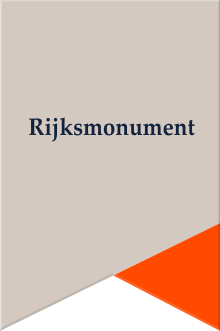Rijksmonument
A rijksmonument (Dutch pronunciation: [ˈrɛiksmoːnyˌmɛnt], lit. 'state monument') is a national heritage site of the Netherlands, listed by the agency Rijksdienst voor het Cultureel Erfgoed acting for the Dutch Ministry of Education, Culture and Science.[1]

At the end of February 2015, the Netherlands had 61,822 listed national heritage sites. About 1,500 of them are archaeological sites.[2][3]
History and criteria
changeUntil 2012, a place had to be over 50 years old to be eligible.[4] The law governing the monuments is the Monumentenwet van 1988 ("Monument Law of 1988").[5]
The organization responsible for caring for the monuments, which used to be called Monumentenzorg, is now called Rijksdienst voor het Cultureel Erfgoed. In June 2009, the Court of The Hague decided that individual purchasers of buildings that were listed as rijksmonuments would be exempt from paying transfer tax, effective from 1 May 2009. Previously this exemption had only applied to legal entities.[6]
Some examples
changeMany Dutch tourist attractions are rijksmonuments, such as castles or windmills. Some notable windmills are De Schoolmeester, Westzaan, a smock mill in North Holland, the only wind powered paper mill in the world,[7] listed as rijksmonument number 40013;[8] De Wieker Meule, De Wijk, in Drenthe province, built in 1829 and restored to working order, listed as rijksmonument number 39657;[9] and Mellemolen, a hollow post mill in Friesland, also restored to working order, listed as rijksmonument number 35937.[10] Among the rijksmonuments are also many churches. Most rijksmonuments are residential buildings, such as houses and villas.
References
change- ↑ "Wat is een rijksmonument?" (in Dutch). Archived from the original on 2012-02-26. Retrieved 2009-08-08.
- ↑ "Aantal rijksmonumenten en beschermde stads- en dorpsgezichten in 2011 | Rijksdienst voor het Cultureel Erfgoed". 2015-04-02. Archived from the original on 2015-04-02. Retrieved 2019-05-01.
- ↑ "Gebouwde rijksmonumenten - aantal | Erfgoedmonitor". erfgoedmonitor.nl (in Dutch). Archived from the original on 2019-05-01. Retrieved 2019-05-01.
- ↑ "Monumenten". monumentenverenigingdoesburg.nl. Retrieved 2019-05-01.
- ↑ "Monumentenwet (1988)" (in Dutch). Cultureel Erfgoed. Retrieved 2009-08-21.
- ↑ "Historical buildings now exempt from tax for individuals". Expatica. Archived from the original on 2009-09-02. Retrieved 2009-08-21.
- ↑ Reynolds, John (1974). Windmills & Watermills. London: Hugh Evelyn. pp. 173–74. ISBN 0-238-78943-8.
- ↑ "Molendatabase: De Schoolmeester te Westzaan". Technische gegevens (in Dutch). Vereniging De Zaansche Molens. Archived from the original on 24 July 2011. Retrieved 24 August 2009.
- ↑ "Molendatabase: De Wieker Meule te De Wijk". Technische gegevens (in Dutch). De Hollandsche Molen. Archived from the original on 24 July 2011. Retrieved 24 August 2009.
- ↑ "Technische gegevens" (in Dutch). De Hollandsche Molen. Archived from the original on 8 October 2011. Retrieved 24 August 2009.